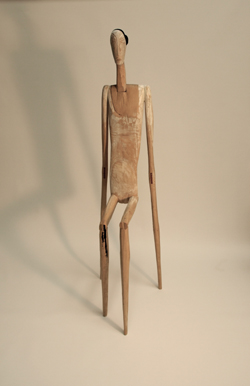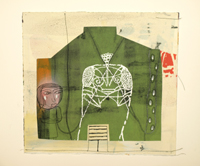Bob Brady has made a career out of creating lithe, attenuated figures out of wood whose inscrutable countenances long ago became iconic within Bay Area art. For his sparseness and economy of means, Brady has been compared to Giacometti whose signature trait –ragged gauntness – is echoed in two other Northern California artists: Manuel Neri and Stephen de Staebler, But where the latter two extend Giacometti’s portrayal of existential angst through rough-surfaced figures that seem to be laboring under great stress, Brady’s sculpture has always conveyed the exact opposite: transcendence and grace.
With improbably long limbs bent into anatomically impossible positions, these figures — which sit, stand, kneel and fold into fetal-like positions — articulate a geometry textbook’s worth of angles and shapes. They suggest, in their negative spaces, as many spatial possibilities as their positive elements do, and they mix delicacy and toughness. The surfaces are gouged and abraded, painted and sanded; yet some of the limbs of these pieces are delicate enough for air currents move them around the axis of the pins that hold them in place.
There’s also a highly personal element. These contorted torsos and their sometimes shoe-gazing stances reference a period in Brady’s life when he was immobilized by a debilitating illness that struck twice, once in childhood and again when he was an adult. Memories of those events seem to have permanently lodged in his output, but their expression is curiously bifurcated: the forms are both sleek and awkward.
These obvious signs of corporeality are counterbalanced by a persistent inscrutability. Since the 1989, when Brady quit ceramics for wood, writers have ascribed to his sculpture all manner of spiritual properties, owing to their incorporation of tribal motifs from all over the globe. Brady, himself, doesn’t claim deep knowledge of these sources; but like Picasso, Brady is acutely aware of their totemic power and he knows how to use it. As it happens, the centerpiece of this show — the three, 7-foot-tall figures of his Natomas series, pointedly reference Cycladic figures, a touchstone modernism. They greet you at the door like a phalanx of mute soldiers and introduce half a dozen similarly styled figures, along with an array of other works – including drawings, wall-mounted sculptures and wire-armature birds — that demonstrate the true breadth of Brady’s art .
The birds – seven multi-media gems built of paper, wood, wire, string, straw and other studio-floor effluvia – testify further to the influence of early modernist practices. Brady’s birds don’t stretch any boundaries, but they do carry his distinct imprint and stand with the best historical examples.
Lately, Brady also seems to have brushed up against high minimalism. Stretched across an entire gallery wall are a series of wooden shields that seem to allude to tools and architectural forms. Painted white, slightly curved, and with small gaps between segments, they are all about shape and edge. They strive for iconic status, and to some extent they achieve it, but they feel like anomalies within Brady’s otherwise expressive oeuvre.
More in character are six multi-layered drawings that recycle in 2-D, visual ideas that have been more or less continuous themes across Brady’s career. Reconfigured in a graphic and sometimes cartoon-like form, and with edges perforated by stitching, they thrust the artist into an almost pop surrealist realm that feels fresh. The same holds for a wall-sized sculpture called Empire, which looks like an Afro comb made from walrus tusks whose gold-leaf trim gives it the aura of an artifact excavated from the tomb of a giant.
Taken together, the 32 pieces in this elegant show could easily stand as an abbreviated retrospective of Brady’s post-ceramic period. They also highlight an aspect of his career that is seldom noted: the path not taken. Where his peers at UC Davis in the mid’60s were busy creating funk, Brady went on to pursue beauty in the form of outsized ceramic vessels. The ancient primitivism embodied in that early work continues to stand as Brady’s trademark as his work it evolves to encompass current trends.
|
Two hit shows, figuratively speaking
By Victoria Dalkey, The Sacramento Bee art correspondent
Brady gives us attenuated, sometimes purely abstract figures, that hover between raw emotion and formal elegance.
In his current outing at b. sakata garo, he takes three approaches to the body, two of which extend previous series.
A group of female figures – "Charry," "Flit IV" and "Lexa" – are as odd and compelling as praying mantises. With their long,
thin bodies and sticklike limbs drawn up, they seem to cling to the wall or spring up from the floor as if they had suddenly
materialized in front of you. "Charry" herself seems surprised by her appearance, her ponytail rising straight up like an exclamation point.
Feminine also, though ostensibly male, is "Tut," a hewn figure of the boy king, looking elegant and vulnerable as he emerges
from the wood in a golden glow. For all its abstraction, it bears an uncanny resemblance to the real Tutenkhamen's golden mask.
Similarly elegant is "Empire," a wall piece that resembles both an elaborate comb for a queen and a set of chimes. The top piece of the sculpture, made
of hammered gold and fragments of Japanese writing, is wonderfully luxurious.
A second series focuses on extremely abstracted figures bent over with their heads – represented as stonelike balls on strings – hanging low. "Natomas 1, 2 and 3" is a veritable forest of figures, hovering between the female forms and the more rigorously reductive "F.P. Blues," which forms a cage made up of two bent-over stick figures. It's a powerful statement about incarceration ("F.P." stands for Folsom Prison).
Finally, Brady shows a series of smooth, blond, shieldlike wall pieces that reference both the human body and diagrams of floor plans for buildings, some like cathedrals or mosques. These are the strangest works in the show and so new and unfamiliar it's difficult to know what to make of them. After extended viewing, they come off as powerful and mysterious as some of the works of Martin Puryear.
Similarly haunting are "Kabul," a form that suggests a shark mask, and "Bodie," an austere black piece that is as cold and
desolate as the high Sierra ghost town it refers to.
b. sakata garo, 923 20th St. (916) 447-4276, www.bsakatagro.
Robert Brady and Mike Riegel have a lot in common. Both have taught for many years at California State University, Sacramento, and both are sculptors whose work focuses on the figure.
They each take a reductive approach to making their enigmatic, simplified figures, and yet there is a world of difference in the results as seen in two separate shows.

"Tut"/Robert Brady.


